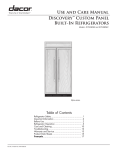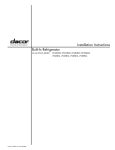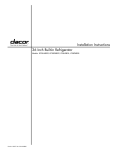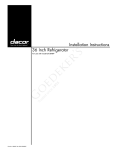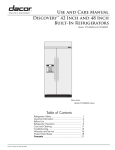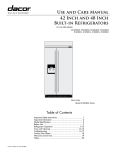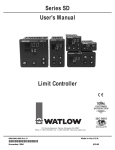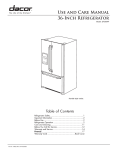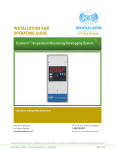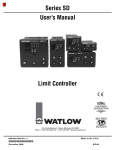Download Dacor DYF48BNDI Specifications
Transcript
Installation Instructions Discovery™ Built-In Refrigerator 42 and 48 Inch Models: DYF42BNDI and DYF48BNDI Part No. 107310 Rev. A/W10565752 Table of Contents Refrigerator Safety........................................................................1 Installation Requirements............................................................2 Tools and Parts............................................................................... 2 Location Requirements...................................................................2 Electrical Requirements..................................................................3 Water Supply Requirements........................................................... 4 Tipping Radius.................................................................................4 Product Dimensions........................................................................5 Door Swing Dimensions.................................................................. 6 Custom Panels................................................................................9 Handles.........................................................................................10 Custom Side Panels...................................................................... 10 Installation Instructions.............................................................. 11 Unpack Refrigerator...................................................................... 11 Reduce Tipping Radius................................................................. 11 Move the Refrigerator into House................................................. 11 Install Anti-Tip Boards................................................................... 12 Connect Water Supply.................................................................. 12 Plug in Refrigerator....................................................................... 13 Move to Final Location.................................................................. 13 Level and Align Refrigerator.......................................................... 14 Adjust Doors..................................................................................16 Install Side Panel(s)...................................................................... 17 Install Base Grille.......................................................................... 17 Complete Installation.....................................................................18 Water System Preparation............................................................ 18 Customer Service Information If you have questions or problems with installation, contact your Dacor ® dealer or the Dacor Customer Service Team. For repairs to Dacor appliances under warranty call the Dacor Distinctive Service line. Whenever you call, have the model and serial number of the appliance ready. These numbers are found on a label located on the right inside wall of the refrigerator compartment. Dacor Customer Service Phone: (800) 793-0093, extension 2813 (U.S.A. and Canada) Monday — Friday 6:00 a.m. to 5:00 p.m. Pacific Time Web site: www.dacor.com Dacor Distinctive Service (repairs under warranty only) Phone: (800) 793-0093, extension 2822 (U.S.A. and Canada) Monday — Friday 6:00 a.m. to 5:00 p.m. Pacific Time All specifications subject to change without notice. Dacor assumes no liability for changes to specifications. © 2013 Dacor, all rights reserved. Refrigerator Safety Your safety and the safety of others are very important. We have provided many important safety messages in this manual and on your appliance. Always read and obey all safety messages. This is the safety alert symbol. This symbol alerts you to potential hazards that can kill or hurt you and others. All safety messages will follow the safety alert symbol and either the word “DANGER” or “WARNING.” These words mean: DANGER WARNING You can be killed or seriously injured if you don't immediately follow instructions. You can be killed or seriously injured if you don't follow instructions. All safety messages will tell you what the potential hazard is, tell you how to reduce the chance of injury, and tell you what can happen if the instructions are not followed. State of California Proposition 65 Warnings: WARNING: This product contains one or more chemicals known to the State of California to cause cancer. WARNING: This product contains one or more chemicals known to the State of California to cause birth defects or other reproductive harm. WARNING Important information to know about disposal of refrigerants: Dispose of refrigerator in accordance with Federal and Local regulations. Refrigerants must be evacuated by a licensed, EPA certified refrigerant technician in accordance with established procedures. Tip Over Hazard Refrigerator is top heavy and tips easily when not completely installed. Keep doors taped closed until refrigerator is completely installed. Use two or more people to move and install refrigerator. Failure to do so can result in death or serious injury. 1 Installation Requirements Tools and Parts Location Requirements IMPORTANT: Your Dacor refrigerator can be recessed in an opening between cabinets or installed at the end of a cabinet run using a side panel to enclose the refrigerator. Installer: Leave these installation instructions with the homeowner. WARNING Homeowner: Keep these installation instructions for future reference. Save them for the local electrical inspector’s use. Tools needed: Gather the required tools and parts before starting installation. Read and follow the instructions provided with any tools listed here. Cordless drill Drill bits Explosion Hazard Two adjustable wrenches Keep flammable materials and vapors, such as gasoline, away from refrigerator. Phillips screwdriver Failure to do so can result in death, explosion, or fire. Small level Appliance dolly Torx ®† T27 screwdrivers ¹¹⁄32” nut driver ³⁄8” and ¹⁄2” open-end wrenches Hex key (5⁄32”) ¹⁄4” and 5/16” socket drivers Tape measure Utility knife Parts Needed: Six #8 x 3” (7.6 cm) wood screws (longer screws may be needed) One or two 2” x 4” x 32” (5.1 cm x 10.2 cm x 81.3 cm) wood board(s) Minimum 7 ft (2.1 m) flexible codes approved water supply line. Consult a qualified cabinetmaker or carpenter to make the custom panels. See page 9 for more information. IMPORTANT: Observe all governing codes and ordinances. It is recommended that you do not install the refrigerator near an oven, radiator, or other heat source. Do not install in a location where the temperature will fall below 55°F (13°C). The floor must support the refrigerator weight, more than 600 lbs (272 kg), door panels and contents of the refrigerator. The ceiling height must allow for side tipping radius. See Tipping Radius. The location should permit doors to open fully. See Door Swing Dimensions. The location must permit top grille removal. See Opening Dimensions. Opening Dimensions To avoid tipping during use, the solid soffit must be within 1” (2.5 cm) maximum above the refrigerator. If the solid soffit is higher than 1” (2.5 cm) or one is not available, then the refrigerator must be braced. If the anti-tip boards are needed, they must be attached to the rear wall studs 80” to 90” (203.2 cm to 228.6 cm) above the floor. See Install Anti-Tip Boards for more information. NOTE: A clearance of ¹⁄2” (1.3 cm) must be maintained above the top grille in order for the top grille to be removed. ¹⁄2” (1.3 cm) † Torx 2 ® is a registered trademark of Saturn Fasteners Inc. Installation Requirements Locate the refrigerator so that it may easily be pulled out from the wall if service becomes necessary. A grounded 3 prong electrical outlet should be placed as shown in the illustration below. See Electrical Requirements for more information. The water shutoff should be located in the base cabinet on either side of the refrigerator or some other easily accessible area. If the water shutoff valve is not in the cabinets, the plumbing for the water line can come through the floor or the back wall. See Water Supply Requirements for more information. Electrical Requirements WARNING Electrical Shock Hazard Plug into a grounded 3 prong outlet. Do not remove ground prong. Do not use an adapter. Do not use an extension cord. Failure to follow these instructions can result in death, fire, or electrical shock. BB Dimension Before you move your refrigerator into its final location, it is important to make sure you have the proper electrical connection. 83¹/21/2” (212.1 cm) " (212.1 cm) min. 83 cm) max. 84 4" (215.3 84³/3/4” (215.3 cm) to bottom of solid soffit Recommended Grounding Method min. A 115 Volt, 60 Hz., AC only 15 or 20 Amp. fused, grounded electrical supply is required. It is recommended that a separate circuit serving only your refrigerator be provided. Use an outlet that cannot be turned off by a switch. Do not use an extension cord. to bottom of solid soffit 77" 77” (195.6 cm) (195.6 cm) IMPORTANT: If this product is connected to a GFCI (ground fault circuit interrupter) equipped outlet, nuisance tripping of the power supply may occur, resulting in loss of cooling. Food quality and flavor may be affected. If nuisance tripping has occurred, and if the condition of the food appears poor, dispose of it. A A (see chart following) (see chart following) NOTE: Before performing any type of installation, cleaning or removing a light bulb, remove the top grille and turn the master power switch to OFF or disconnect power at the circuit breaker box. When you are finished, turn ON the main power switch or reconnect power at the circuit breaker box. Then reset the control to the desired setting. 24” 24" (61.0 cm) (61.0 cm)Min. min. See page 5 Model Cutout Width A Dimension B DYF42BNDI 41½” (105.4 cm) to 41¾” (106.0 cm) 10” (25.4 cm) DYF48BNDI 47½” (120.7 cm) to 47¾” (121.3 cm) 16” (40.6 cm) NOTE: Flooring under refrigerator must be at same level as the room. The face of the cabinetry must be plumb. 3 Installation Requirements Water Supply Requirements If the water pressure to the reverse osmosis system is less than 40 to 60 psi (276 to 414 kPa): All installations must meet local plumbing code requirements. Check to see whether the sediment filter in the reverse osmosis system is blocked. Replace the filter if necessary. The water shutoff should be located in the base cabinet on either side of the refrigerator or some other easily accessible area. The right-hand side is recommended. NOTE: If the water shut off valve is in the back wall behind the refrigerator, it must be at an angle so that the water line is not kinked when the refrigerator is pushed into its final position. Allow the storage tank on the reverse osmosis system to refill after heavy usage. If your refrigerator has a water filter cartridge, it may further reduce the water pressure when used in conjunction with a reverse osmosis system. Remove the water filter cartridge. Tipping Radius 1” x 1” (2.5 cm x 2.5 cm) Be sure there is adequate ceiling height to stand the refrigerator upright when it is moved into place. The dolly wheel height must be added to the tipping radius when a dolly is used. Possible water line locations If needed, the tipping radius can be reduced. See Reduce Tipping Radius. Side Tipping Radius 6” (15.2 cm) 1” (2.5 cm) 6” (15.2 cm) The side tipping radius varies depending upon the width of the model. Use the chart provided to determine the side tipping radius. If the water shutoff valve is not in the cabinets, the plumbing for the water line can come through the floor. A ¹⁄2” (1.3 cm) hole for plumbing should be drilled at least 6” (15.2 cm) from the right or left hand side cabinet or panel. On the floor, the hole should be no more than 1” (2.5 cm) away from the back wall. See Connect Water Supply. Install the water supply line only in areas where the household temperatures will remain above freezing. Do not use a piercing-type or ³⁄16” (4.8 mm) saddle valve which reduces water flow and clogs more easily. NOTE: Your refrigerator dealer has a kit available with a ¹⁄4” (6.4 mm) saddle-type shutoff valve. Make sure a saddle-type valve complies with your local plumbing codes. Water Pressure A cold water supply with water pressure between 30 and 120 psi (207 and 827 kPa) is required to operate the water dispenser and ice maker. If you have questions about your water pressure, call a licensed, qualified plumber. Reverse Osmosis Water Supply IMPORTANT: The pressure of the water supply coming out of a reverse osmosis system going to the water inlet valve of the refrigerator needs to be between 30 and 120 psi (207 and 827 kPa). If a reverse osmosis water filtration system is connected to your cold water supply, the water pressure to the reverse osmosis system needs to be a minimum of 40 to 60 psi (276 to 414 kPa). 4 A NOTE: Tip on side only. Model Tipping Radius A DYF42BNDI 93” (236.2 cm) DYF48BNDI 96” (243.8 cm) Installation Requirements Product Dimensions Side View: Front View: The depth from the front of the top grille to the back of the refrigerator cabinet is 25 ³⁄8” (64.5 cm). The width dimensions were measured from trim edge to trim edge. The power cord is 84” (213.3 cm) long. Height dimensions are shown with leveling legs extended ¹⁄8” (3.2 mm) below the rollers. The height dimensions are shown with leveling legs extended ¹⁄8” (3.2 mm) below the rollers. 25³⁄8” (64.5 cm) 23¹⁄2” (59.7 cm) *83³⁄8” (211.8 cm) *83³⁄8” (211.8 cm) 84” (213.4 cm) Power cord B (see following chart) *3¹⁄2” (8.9 cm) * When the leveling legs are fully extended to 1¼” (3.2 cm) below the rollers, add 1¹⁄8” (2.9 cm) to the height dimensions. Model Width B (Trim edge to trim edge) DYF42BNDI 42¼” (107.3 cm) DYF48BNDI 48¼” (122.6 cm) * When the leveling legs are fully extended to 1¼” (3.2 cm) below the rollers, add 1¹⁄8” (2.9 cm) to the height dimensions. Top View: A 25³⁄8” (64.5 cm) Model Width A DYF42BNDI 41” (104.1 cm) DYF48BNDI 47” (119.4 cm) 5 Installation Requirements Door Swing Dimensions The location must permit both doors to open to a minimum of 90°. Allow 4½” (11.4 cm) minimum space between the side of the refrigerator and a corner wall. To adjust the door swing, see Adjust Doors. Model DYF42BNDI 12 5⁄ 8 " (32.1 cm) 411⁄2 " (105.4 cm) 371⁄ 4" (94.6 cm) 16 7⁄8 " (42.9 cm) 413⁄ 8" (105.1 cm) 477⁄8" (121.6 cm) 90˚ 110˚ 130˚ 90˚ 110˚ 130˚ Model DYF48BNDI 14 3⁄8 " (36.5 cm) 44" (111.8 cm) 39" (99.1 cm) 19 1⁄4 " (48.9 cm) 513⁄8 " (130.5 cm) 437⁄8 " (111.4 cm) 90˚ 110˚ 130˚ 6 90˚ 110˚ 130˚ Installation Requirements Door Panels and Cabinetry Clearance - Door Swing 110° The custom door panels and adjacent cabinetry must be designed so that there is sufficient clearance for the doors to swing open. If the refrigerator is to be installed close to the wall, see Door Swing 90° on following page. Refrigerator to Cabinetry Clearance Door swing 110° actual size Refrigerator Side Trim 1 ½" (3.8 cm) 1 ¼" (3.2 cm) 1" (2.5 cm) Cabinetry ¼" (6.35 mm) Hinge ½" (1.3 cm) ¾" (1.9 cm) 1" (2.5 cm) NOTE: Allow ½ (1.3 cm) clearance between overlay panel and cabinetry. ½" (1.3 cm) ¾" (1.9 cm) 1" (2.5 cm) Ove 1 ¼" (3.2 cm) rlay 1½ " (3.8 cm) l l e Pan e Pan ker Bac r Doo NOTE: Rout the hinge side of the custom door panels to a radius that is equal to at least half the thickness of the panel if a 130° door swing is desired. See Adjust Doors. Spacer Panel When the doors are closed the refrigerator will extend beyond the face of the adjacent cabinetry to some degree. 7 Installation Requirements Door Panels and Cabinetry Clearance - Door Swing 90° Refrigerator to Cabinetry Clearance Door swing 90° actual size Refrigerator Side Trim 1" (2.5 cm) ¾" (1.9 cm) ½" (1.3 cm) 90˚ Door Stop Position Cabinetry ¼" (6.35 mm) Hinge ½" (1.3 cm) ¾" (1.9 cm) 1" (2.5 cm) Overlay Panel Backer Panel Door ½" (1.3 cm) ¾" (1.9 cm) 1" (2.5 cm) 1¼ (3.2 cm) 1½ (3.8 cm) Spacer Panel Allow a minimum of 4 ½” (11.4 cm) of space between the side of the refrigerator and a corner wall. More clearance may be needed if thicker custom panels or custom handles are used. Do not overlook baseboards. 8 Installation Requirements Custom Panels Overlay panel Spacer panel Spacer panel The custom overlay panels allow you to blend the exterior of your refrigerator into the overall kitchen décor, and to use custom handles for additional design flexibility. 1/8" (3.2 mm) The custom panels must have backer panels attached in order to mount them to the refrigerator. It is most common to work with three panels, as shown in the graphic on the right. A decorative overlay panel, a ¹/8” (3.2 mm) spacer panel or spacer strips and a ¼” (6.4 mm) backer panel. 1" M (2.5 In some cases, your cabinet manufacturer may choose to work with one panel routed for the different dimensions. Follow these panel dimension and placement instructions to be sure that the custom overlay panels will fit properly. / " to 3/4" (1.6 to 1.9 cm) Backer panel 58 Overlay IMPORTANT: Install the panels after moving the panel refrigerator into place. The weight of the overlay panels cannot exceed: / 50 lbs. (22.7 kg) for the refrigerator door. 1 8" Overlay panel (3.2 mm) 40 lbs. (18.1 kg) for the freezer door. 10 lbs. (4.5 kg) for the top grille. To minimize panel weight, you may use 2” (5.1 cm) spacer strips around the perimeter in place of full-sheet solid spacer panels. The spacer strips must be set in at least 1” (2.5 cm) from the top, bottom and sides edges of the backer panel. If you use spacer Side View strips, it is also recommended that you use two 2” (5.1 cm) strips Backer panel horizontally centered for added support. 5/8" to 3/4" 1/4" (1.6 to 1.9 cm) 1/8" (6.4 mm) (3.2 mm) Top grille Freezer panel 6 3/16" (15.7 cm) C Backer side offset ½" (1.3 cm) G F G 71/4" (18.4 cm) A G 1" min. (2.5 cm) Door Trim frame Offset dimension Refrigerator panel B G Overlay panel Backer panel ½" (1.3 cm) Backer bottom offset B C 17¼” 23¼” 40¾” DYF42 (43.8 cm) (59.1 cm) (103.5 cm) DYF48 Backer panel A D Decorative Overlay Panels Model Series Offset d 1/4" / (6.4 mm) Spacer panel (3.2 mm) Spacer panel 1 8" Backer handle-side offset ¹⁄8 " (3.2 mm) 70¹⁄2 " (179.1 cm) E 70¹⁄2 " (179.1 cm) 72 ¼ " (183.5 cm) 19¾ ” 26¾” 46¾” (50.2 cm) (68.0 cm) (118.8 cm) Backer Panels Model Series DYF42 D E F 16¾” 22¾” 39¾” (42.6 cm) (57.8 cm) (101.0 cm) 19¼” 26¼” 45¾” DYF48 (48.9 cm) (66.7 cm) (116.2 cm) G Backer bottom offset ¹⁄8 " (3.2 mm) Backer bottom offset ¹⁄8 " (3.2 mm) G G - Denotes top and bottom edges of backer panel that slide into trim frame on door and top grille. 9 Installation Requirements Handles 3 3 • Before installing a custom panel assembly, you must install the custom handle hardware. The handle and handle mounting hardware are not provided with the refrigerator. • Dacor recommends handles with larger D-style pulls. Any handle designed for use with an appliance should produce satisfactory results. Handle kits are available through your Dacor dealer. ⁄8” (9.7 mm) ⁄16” (4.8 mm) Side Trim • Handle kits do not include the necessary mounting screws since screw length required varies with the total thickness of the panels. The panel craftsman must determine and obtain the proper fasteners for the application. If using screws with thick heads, they must be countersunk into the panel before installing the handles. 1 ⁄16” (1.5 mm) IMPORTANT: Dacor does not advise the use of single pull knobs. B 3 ⁄32” (2.4 cm) NOTES: A The dimensions shown are actual product dimensions and may not reflect the needed installation dimensions. Trim frame Door C 20” typ. (50.8 cm) 36” max. (91.4 cm) A. Countersunk screw B.Handle C. Door panel assembly The side panel should be a minimum of ½” (1.3 cm) thick to avoid warping. If the opening depth is 25” (63.5 cm) or more, you may want to install a support board on the rear wall. Inset Installation Dimensions 1. Measure the distance from point A (as shown) to the back wall. Add 1⁄32” (0.8 mm) to this measurement to allow the side panel to fit into the trim. 2. If the panel is more than 3/8” (9.5 mm) thick, route the front edge to allow the side panel to fit into the trim. Handle Detail Custom Side Panels Custom side panels may be needed when not enough space is available to have cabinets on both sides of the refrigerator or when the refrigerator is placed at the end of a cabinet run. You may choose an inset, flush or recessed inset panel installation. Refrigerator and Side Trim Dimensions Back wall A The width and height of a side panel are determined by the type of installation you are planning. Overlay Recessed Inset Installation Dimensions 1. Measure the distance from point B (as shown) to the back wall. 2311⁄16” (60.2 cm) 2. Rout the front edge of the support board or attach a 3/8” (9.5 mm) board to hold the panel in the cabinet side trim. Back wall B Refrigerator 10 Installation Instructions Unpack Refrigerator WARNING 1. Grasp both ends of the top grille. 2. Push the top grille straight up, then pull straight out. Lay the grille on a soft surface. B A B Tip Over Hazard Refrigerator is top heavy and tips easily when not completely installed. Keep doors taped closed until refrigerator is completely installed. A. Top grille B. Cabinet side trim 3. Remove the six screws attaching each cabinet side trim to the refrigerator and remove the side trims. Use two or more people to move and install refrigerator. Move the Refrigerator into House Failure to do so can result in death or serious injury. IMPORTANT: WARNING If you receive a damaged product, immediately contact your dealer or builder. Do not install or use a damaged appliance. Do not remove the film on the outside until the refrigerator is in its operating position. All four leveling legs must contact the floor to support and stabilize the full weight of the refrigerator. Keep the cardboard shipping piece or plywood under the refrigerator until it is installed in the operating position. 1. Remove and save the literature package bag taped to the side of the refrigerator and the parts bag behind the grille. Remove the four brackets (two on each side) that attach the shipping base to the refrigerator bottom. NOTE: Do not remove tape and door bracing until the refrigerator is in its final position. 2. If necessary, reduce the tipping radius. See Tipping Radius for ceiling height requirements or Reduce Tipping Radius for stepby-step instructions. If you do not need to reduce the tipping radius, proceed to Move the Refrigerator into House. Reduce Tipping Radius (if required) Before bringing the refrigerator into the home, be sure there is adequate ceiling height to stand the refrigerator upright. See Tipping Radius. If you do not have adequate ceiling height to stand the refrigerator upright, the tipping radius can be reduced by removing the top grille and side trims (see the following chart). Model Reduced Tipping Radius DYF42BNDI 88½” (224.8 cm) DYF48BNDI 89¼” (226.7 cm) Tip Over Hazard Refrigerator is top heavy and tips easily when not completely installed. Keep doors taped closed until refrigerator is completely installed. Use two or more people to move and install refrigerator. Failure to do so can result in death or serious injury. 1. Place an appliance dolly under the left side of the refrigerator as shown. Be sure to avoid damaging the side trims and handles. Place the corner posts from the packing materials over the trims and handles as appropriate. Slowly tighten the strap. 2. Place pieces of the shipping carton on the floor when rolling the dolly and refrigerator into the house. Move the refrigerator close to the built-in opening. 3. Place top of cardboard carton or plywood under the refrigerator. 4. Stand the refrigerator up. First, place the left bottom edge of the refrigerator on the floor, stand the refrigerator upright and then lower the right-hand side of the refrigerator to the floor. 5. Reassemble the trim and top grille after the dolly has been removed from the refrigerator. 11 Installation Instructions Install Anti-Tip Boards Connect Water Supply IMPORTANT: Read all directions before you begin. To avoid tipping during use, the solid soffit must be within 1” (2.5 cm) maximum above the refrigerator. If the solid soffit is higher than 1” (2.5 cm) or one is not available, then the refrigerator must be braced. IMPORTANT: If you turn the refrigerator on before the water line is connected, turn the ice maker OFF. It is recommended that board(s) be installed before the refrigerator is installed. NOTE: If the existing water line meets the Water Supply Requirements, see Connecting to Refrigerator. Board(s) must be long enough to fully cover the width of the compressor cover. 1. Unplug the refrigerator or disconnect power. Locate the board(s) so the bottom surface(s) of the board(s) is (are) 84” (213.4 cm) from the floor. During installation, raise the refrigerator up so there is ¼” (6.4 mm) maximum between the top of the refrigerator and the bottom of the anti-tip board(s). Do not crush the compressor cover when raising the rear leveling legs. To Install Anti-tip Boards 1. Mark the stud locations on the rear wall 80” to 90” (203.2 cm to 228.6 cm) above the floor. 2. Securely attach one or two 2” x 4” x 32” (5.1 cm x 10.2 cm x 81.3 cm) boards to the wall studs behind refrigerator. Use six #8 x 3” (7.6 cm) (or longer) wood screws. The wood screws must be screwed into the studs at least 1½” (3.8 cm). The board(s) must overlap the compressor cover. A B Install Saddle Valve 2. Turn OFF the main water supply. Turn ON the nearest faucet long enough to clear the line of water. 3. Locate a ½” to 1¼” (1.3 cm to 3.2 cm) vertical cold water pipe near the refrigerator. IMPORTANT: Make sure it is a cold water pipe. A horizontal pipe will work, but drill on the top side of the pipe, not the bottom. Doing so will help keep water away from the drill and normal sediment from collecting in the valve. 4. Using a cordless drill, drill a ¼” (6.4 mm) hole in the cold water pipe you have selected. 5. Fasten the shutoff valve to the cold water pipe with the pipe clamp. Be sure the outlet end is solidly in the ¼” (6.4 mm) drilled hole in the water pipe and that the washer is under the pipe clamp. Tighten the packing nut. Tighten the pipe clamp screws slowly and evenly so the washer makes a watertight seal. Do not overtighten. A C B C 2” (5.1 cm) D A. Cold water pipe B. Pipe clamp C. Packing nut D. Shutoff valve 6. Turn on the main water supply. D A. Center board 1/4” (6.4 mm) max. above refrigerator B. Two 2” x 4” x 32” (5.1 cm x 10.2 cm x 81.3 cm) boards C. Attach to studs with six #8 x 3” (7.6 cm) screws D. Compressor cover 12 7. Check for leaks around the saddle valve. IMPORTANT: Before attaching the water supply line to the shutoff valve, flush the main water supply line to remove particles and air in the water line. Allow enough flow so that the water becomes clear. Flushing the water line may help avoid filters and/or water valves from becoming clogged. Installation Instructions Connect Water Supply (cont.) Connecting to Refrigerator Parts Supplied: ¼” to ¼” (6.4 mm to 6.4 mm) male to male coupling. Plug in Refrigerator WARNING 1” x 1” (2.5 cm x 2.5 cm) Possible water line locations Electrical Shock Hazard Plug into a grounded 3 prong outlet. Do not remove ground prong. Do not use an adapter. Do not use an extension cord. 1” (2.5 cm) Failure to follow these instructions can result in death, fire, or electrical shock. 7” (17.8 cm) 1. Set the control switch at top of cabinet to the OFF position. 2. Plug the refrigerator into a grounded 3 prong outlet. Move to Final Location NOTE: The flexible codes approved water supply line can connect to the supply valve through the floor or through the side cabinets, as indicated by the gray boxes above. WARNING 1. Unplug the refrigerator or disconnect power. 2. Connect the 7 ft (2.1 m) minimum flexible codes approved water tube to the water supply valve. 3. Flush the main water supply line to remove particles and air in the water line. Allow enough flow so that the water becomes clear. 4. Tape the water supply line to the floor, 7” (17.8 cm) from the left side of the refrigerator. Tape along the length of the tubing, which will allow it to pass beneath the refrigerator without interference. NOTE: Allow a minimum of 26” (66.0 cm) of flexible codes approved water supply line to be loose at the front of the refrigerator for connecting to the household water line. 5. Connect the water supply line to the refrigerator. NOTE: If the main water shutoff valve is behind the refrigerator, a secondary water shutoff valve may be installed in line with the water supply line at the front of the product. A. Household water line B.Coupling C. Bulb A D.Nut E. Refrigerator water tubing Tip Over Hazard Refrigerator is top heavy and tips easily when not completely installed. Keep doors taped closed until refrigerator is completely installed. Use two or more people to move and install refrigerator. Failure to do so can result in death or serious injury. IMPORTANT: To avoid floor damage, make sure the levelers are raised (not touching floor) and refrigerator is on rollers before moving. 1. Place the top of the cardboard carton or plywood under refrigerator. Remove dolly. 2. Do not remove the film on the outside. B C D E 3. Move the refrigerator straight back and evenly into the opening. Be sure the refrigerator side trims do not interfere with the door opening. Also, be sure that the water tubing is not kinked and the power cord is on top of the refrigerator. 6. Turn on the water valve and check all connections for leaks. 13 Installation Instructions Level and Align Refrigerator 3. Continue adjusting all of the leveling legs to raise the refrigerator until the top is within at least 1” (2.5 cm) of the top soffit. WARNING NOTE: If an anti-tip board has been used, adjust the leveling legs until the top of the refrigerator is within ¼” (6.4 mm) of the bottom of the anti-tip board as shown. Do not crush the compressor cover. A B Tip Over Hazard Refrigerator is top heavy and tips easily when not completely installed. C Keep doors taped closed until refrigerator is completely installed. Use two or more people to move and install refrigerator. 2” (5.1 cm) Failure to do so can result in death or serious injury. IMPORTANT: All four leveling legs must contact the floor to support and stabilize the full weight of the refrigerator. The rollers are for moving the refrigerator and not for permanent support. After moving the refrigerator to its final location: 1. Use a 5⁄16” socket driver to turn the leveling bolts clockwise to extend the legs to the floor as shown. The rollers should be off the floor. A A B B A. Rear leveling bolt B. Front leveling bolt 2. Adjust the leveling legs to level and align the refrigerator from left to right and front to back so that the refrigerator is level and aligned with the cabinetry. The cabinetry surface must be plumb for the ideal fit of the refrigerator side trim. 14 D A. Center board 1/4” (6.4 mm) max. above refrigerator B. Two 2” x 4” x 32” (5.1 cm x 10.2 cm x 81.3 cm) boards C. Attach to studs with six #8 x 3” (7.6 cm) screws D. Compressor cover IMPORTANT: Adjust in small increments to keep from damaging the cabinet trim and causing problems with the door alignment or top grille fit. To avoid damage to the cabinet or leveling legs, do not apply more than 50 inch-pounds (5.7 Nm) of torque to the leveling bolts. The leveling legs can be extended to a maximum of 1¼” (3.2 cm) below the rollers. Installation Instructions Custom Panel and Handle Installation IMPORTANT: Install the custom handles prior to installing the panels on the refrigerator. Create custom door overlay panels according to the specifications in the Custom Panels and Handles section. Dacor is not responsible for customer installed molding or decorative panels that need to be removed or replaced to service the refrigerator. 3. Slide the panel into the top grille channel and reattach the end cap. G.Panel 4. Replace the top grille in the cabinet side trims and pull the panel down slightly to lock it into place. G Door Panel Installation Handle Installation Before installing a custom panel assembly, install the custom handle hardware. 1. Remove all tape and door bracing from the refrigerator and freezer doors. Counter-sink the screw head into the back of the panel to allow the panel to slide into place smoothly and for proper fit. 3. Remove the handle side and top trims. B 2. Open the refrigerator and freezer compartment doors. A A A A. Countersunk screw B.Handle C. Door panel assembly C Side View Front Front View View Top Grille Panel Installation 1. Grasp both ends of the top grille. Push straight up, then pull straight out. Place the top grille panel-side down on a soft working surface. B A.Trims 4. Slide the custom panels into the bottom and hinge side trims on the refrigerator compartment and freezer compartment doors, making sure that the backer panel fits into the hinge side trims. B A B B A. Top grille B. Cabinet side trim 2. Remove one end cap by loosening the nuts and sliding off the end cap. C B.Panels 5. Reinstall the handle-side and top trims. E C. Bottom rail D.Nuts E. End cap F. Top rail D F C 6. Remove the film from the screw covers C. Slide or snap the screw covers into the handle trim section. 7. Check refrigerator level and alignment. Adjust if needed. 15 Installation Instructions Adjust Doors Door Height Adjustment Use the following steps to adjust the door height, up or down, after the doors have been leveled. 1. Open the freezer or refrigerator door. Locate the bottom hinge and remove the door stop screw. 2. Remove the door stop screw from the bottom side of the hinge with a ³⁄8” open end wrench. 5. After adjusting, check the doors to make sure they are even at the top and bottom. If the doors are not even, continue to turn the bushing to adjust the door height. 6. Replace the locking plate. 7. Turn the bushing slightly to align the hinge and locking plate screw holes. 8. Replace the door stop screw or screws and tighten. 9. Make a final recheck to make sure the doors are aligned and even. Door Swing Adjustment 1. Check that the refrigerator door can open freely. If the door opens too wide, remove the door stop screw or screws (depending on your model) from the bottom hinge. See Door Height Adjustment earlier in this section. 2. Hold the door open to a position that is less than 90°. 3. Replace the door stop screw or screws in the bottom hinge and tighten. A B C A.Bushing B. Door stop screw C. Locking plate 3. Remove the locking plate as shown. B C A A.130° B. 110° (depends on model) C.90° 4. Turn the bushing located underneath the bottom of the hinge using a ½” open end wrench. Turning the bushing to the left (counterclockwise) will raise the door. Turning the bushing right (clockwise) will lower the door. Door-to-Door or Door-to-Refrigerator Trim Adjustment ® 1. Loosen, but do not remove, the four Torx 27 flat-head mounting screws and the two ¼” hex head mounting screws. 2. Adjust the top hinge of either door to align it with the other door or the refrigerator trim. ® 3. Tighten the four Torx 27 flat-head mounting screws to a torque of approximately 100 inch-pounds (11.3 Nm) and tighten the two ¼” hex head mounting screws. A B ® A.Torx 27 flat-head mounting screws B. 1/4” hex-head mounting screws 16 Installation Instructions Install Side Panel(s) 3. Snap the skirt onto the base grille. If the built-in area depth is 25” (63.5 cm) or more, the side panels can be installed inside the side trim or attached to the outside of the side trim. IMPORTANT: Dacor is not responsible for customer installed molding or decorative panels that need to be removed or replaced to service the refrigerator. 1. For the inside side trim piece, slide the front edge of the routed side panel into the trim piece. A 2. Nail the rear edge of the panel to the support board. B A A. Base grille B.Skirt 4. Trim the skirt by scoring the proper “V” groove with a utility knife. Break the skirt at the score line. C C. “V” groove 5. Using the two screws, attach the base grille assembly to the refrigerator as shown. NOTE: Drive in the right side screw first. B A. Support board (mounted to back wall) B. Cab side trim Install Base Grille There are two pieces to the base grille to allow for a custom fit: the base grille itself and the skirt. The skirt can be added to the base grille in order to extend it all the way to the floor. 1. To see if the skirt is needed, place the base grille into position. Do not attach the base grille to the refrigerator. Measure the distance between the bottom of the base grille and the floor. The gap must be a minimum of ½” (1.3 cm) in order to add the skirt. NOTE: If the gap measures less than ½” (1.3 cm), skip steps 3 and 4 of the instructions, and install the base grille only. D D. Screws (2) 2. Remove the film from the base grille. 17 Installation Instructions Complete Installation 1. Turn the water supply line valve to the “Open” position. 2. Turn the refrigerator switch to the ON position. See Power On/ Off Switch in the use and care manual for instructions. Wait a few minutes. Check the water line connections for leaks. 3. Remove all boxes, parts packages and packing materials from the interior of the refrigerator. See the Care and Cleaning section in the use and care manual for instructions. Remove the film and cardboard from the grille and doors or door frame, depending on your model. 4. Install the shelves and bins in the refrigerator and freezer compartments. 5. The controls are preset at the factory to the midpoint setting. Check that the compressor is operating properly and that all the lights are working. 6. Flush the water system before use. See below. Water System Preparation Please read before using the water system. IMPORTANT: After connecting the refrigerator to a water source or replacing the water filter, follow the steps below to make sure that the water system is properly cleaned. Do not use with water that is microbiologically unsafe or of unknown quality without adequate disinfection before or after the system. Systems certified for cyst reduction may be used on disinfected waters that may contain filterable cysts. 1. Turn on the ice maker. Lower the wire shutoff arm as shown. 2. Allow 24 hours to produce the first batch of ice. 3. Allow 3 days to completely fill ice container. Fill and discard three full containers of ice to prepare the water filter for use, before using the ice. 4. Depending on your model, you may want to select the maximum ice feature to increase the production of ice. To get the most efficient use from your new built-in refrigerator, read your use and care manual. Keep Installation Instructions and the use and care manual near the refrigerator for easy reference. Any questions or problems with this installation should be directed to your Dacor dealer or the Dacor Customer Service Team at (800) 793-0093 or visit our web site at www.dacor.com. If you need service, be sure to have the model and serial numbers when you call. You’ll find these numbers on the serial number plate, located on the right hand side of the fresh food compartment. 18 Dacor ● 14425 Clark Avenue, City of Industry, CA 91745 ● Phone: (800) 793-0093 ● Fax: (626) 403-3130 ● www.dacor.com






















